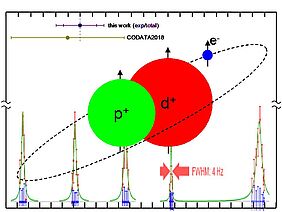Test of quantum electrodynamics and determination of fundamental constants with cold trapped HD+ ions.
The Standard Model predicts and describes with correctness a number of phenomena in various branches of physics but it takes into account a small part of the actual structure of our Universe. The comparison of theoretical predictions and experimental results enables testing validity of the Standard Model and to determine the values of the fundamental constants, parameters which are not predicted by the theory.
A comparison was realized within the framework of a collaboration involving the members of the Molecular Physics at Interfaces team at the PhLAM, the Institute for Experimental Physics at the Heinrich-Heine-Universität (Düsseldorf, Germany) and the Bogoliubov Laboratory of Theoretical Physics at the Joint Institute for Nuclear Research (Dubna, Russia). The work recently published in Nature exploits the tools of the molecular physics and spectroscopy for the HD+ ion, the simplest quantum system made of three different particles bound by electrostatic forces. The lowest rotational frequency of HD+, located in the Terahertz spectral domain, was measured with record precision reaching eleven significant decimal digits, by using approaches relevant for the quantum technologies, such as the ion trapping and laser cooling of atoms and molecules. The rotation of HD+ is described by the quantum electrodynamics, a theory developed starting from 1940’s. Progresses made during the last twenty years in ab-initio calculations with the HD+ ion allowed to reach sufficient precision to predict the rotational frequency. However, the theoretical predictions depend on the values of the fundamental constants, derived from actual theories at different accuracy levels by the CODATA (Committee on Data for Science and Technology).
The results demonstrate agreement between the prediction of the three-body quantum theory and the experimental measurements at an unprecedented level which is limited by the uncertainties of the fundamental constants recommended by the CODATA. Values of the combinations of fundamental constants were determined in agreement but with better accuracy than the CODATA values. Moreover, the constraint on the effect of a hypothetical fifth force between the proton and the deuteron was improved by 20 times. Some physical phenomena beyond the Standard Model, if they exist, remain unidentified in the laboratory !
Publication:
S. Alighanbari, GS Giri, FL Constantin, VI Korobov & S. Schiller, Precise test of quantum electrodynamics and determination of fundamental constants with HD+ ions, NATURE (2020)
DOI: 10.1038 / s41586-020-2261-5
https://www.nature.com/articles/s41586-020-2261-5
Contact:Florin Lucian Constantin, CNRS researcher
florin.constantin[chez]univ-lille[point].fr

